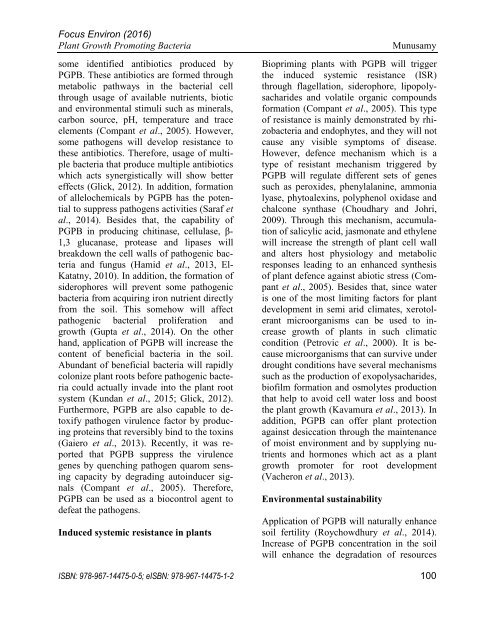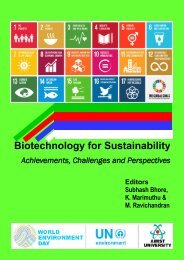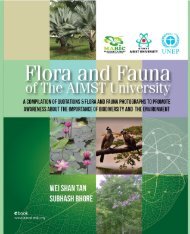Focus on Environment
This book is the Proceedings of the ‘National Seminar on Sustainable Environment and Health 2016’ & ‘World Environment Day-2016 (WED-2016)’ events held on the campus of AIMST University, Kedah, Malaysia. ISBN: 978-967-14475-0-5 (Print version); eISBN: 978-967-14475-1-2 (e-Book version) Editors Subhash Bhore & K. Marimuthu
This book is the Proceedings of the ‘National Seminar on Sustainable Environment and Health 2016’ & ‘World Environment Day-2016 (WED-2016)’ events held on the campus of AIMST University, Kedah, Malaysia.
ISBN: 978-967-14475-0-5 (Print version); eISBN: 978-967-14475-1-2 (e-Book version)
Editors
Subhash Bhore & K. Marimuthu
You also want an ePaper? Increase the reach of your titles
YUMPU automatically turns print PDFs into web optimized ePapers that Google loves.
<str<strong>on</strong>g>Focus</str<strong>on</strong>g> Envir<strong>on</strong> (2016)<br />
Plant Growth Promoting Bacteria<br />
some identified antibiotics produced by<br />
PGPB. These antibiotics are formed through<br />
metabolic pathways in the bacterial cell<br />
through usage of available nutrients, biotic<br />
and envir<strong>on</strong>mental stimuli such as minerals,<br />
carb<strong>on</strong> source, pH, temperature and trace<br />
elements (Compant et al., 2005). However,<br />
some pathogens will develop resistance to<br />
these antibiotics. Therefore, usage of multiple<br />
bacteria that produce multiple antibiotics<br />
which acts synergistically will show better<br />
effects (Glick, 2012). In additi<strong>on</strong>, formati<strong>on</strong><br />
of allelochemicals by PGPB has the potential<br />
to suppress pathogens activities (Saraf et<br />
al., 2014). Besides that, the capability of<br />
PGPB in producing chitinase, cellulase, β-<br />
1,3 glucanase, protease and lipases will<br />
breakdown the cell walls of pathogenic bacteria<br />
and fungus (Hamid et al., 2013, El-<br />
Katatny, 2010). In additi<strong>on</strong>, the formati<strong>on</strong> of<br />
siderophores will prevent some pathogenic<br />
bacteria from acquiring ir<strong>on</strong> nutrient directly<br />
from the soil. This somehow will affect<br />
pathogenic bacterial proliferati<strong>on</strong> and<br />
growth (Gupta et al., 2014). On the other<br />
hand, applicati<strong>on</strong> of PGPB will increase the<br />
c<strong>on</strong>tent of beneficial bacteria in the soil.<br />
Abundant of beneficial bacteria will rapidly<br />
col<strong>on</strong>ize plant roots before pathogenic bacteria<br />
could actually invade into the plant root<br />
system (Kundan et al., 2015; Glick, 2012).<br />
Furthermore, PGPB are also capable to detoxify<br />
pathogen virulence factor by producing<br />
proteins that reversibly bind to the toxins<br />
(Gaiero et al., 2013). Recently, it was reported<br />
that PGPB suppress the virulence<br />
genes by quenching pathogen quarom sensing<br />
capacity by degrading autoinducer signals<br />
(Compant et al., 2005). Therefore,<br />
PGPB can be used as a bioc<strong>on</strong>trol agent to<br />
defeat the pathogens.<br />
Induced systemic resistance in plants<br />
Munusamy<br />
Biopriming plants with PGPB will trigger<br />
the induced systemic resistance (ISR)<br />
through flagellati<strong>on</strong>, siderophore, lipopolysacharides<br />
and volatile organic compounds<br />
formati<strong>on</strong> (Compant et al., 2005). This type<br />
of resistance is mainly dem<strong>on</strong>strated by rhizobacteria<br />
and endophytes, and they will not<br />
cause any visible symptoms of disease.<br />
However, defence mechanism which is a<br />
type of resistant mechanism triggered by<br />
PGPB will regulate different sets of genes<br />
such as peroxides, phenylalanine, amm<strong>on</strong>ia<br />
lyase, phytoalexins, polyphenol oxidase and<br />
chalc<strong>on</strong>e synthase (Choudhary and Johri,<br />
2009). Through this mechanism, accumulati<strong>on</strong><br />
of salicylic acid, jasm<strong>on</strong>ate and ethylene<br />
will increase the strength of plant cell wall<br />
and alters host physiology and metabolic<br />
resp<strong>on</strong>ses leading to an enhanced synthesis<br />
of plant defence against abiotic stress (Compant<br />
et al., 2005). Besides that, since water<br />
is <strong>on</strong>e of the most limiting factors for plant<br />
development in semi arid climates, xerotolerant<br />
microorganisms can be used to increase<br />
growth of plants in such climatic<br />
c<strong>on</strong>diti<strong>on</strong> (Petrovic et al., 2000). It is because<br />
microorganisms that can survive under<br />
drought c<strong>on</strong>diti<strong>on</strong>s have several mechanisms<br />
such as the producti<strong>on</strong> of exopolysacharides,<br />
biofilm formati<strong>on</strong> and osmolytes producti<strong>on</strong><br />
that help to avoid cell water loss and boost<br />
the plant growth (Kavamura et al., 2013). In<br />
additi<strong>on</strong>, PGPB can offer plant protecti<strong>on</strong><br />
against desiccati<strong>on</strong> through the maintenance<br />
of moist envir<strong>on</strong>ment and by supplying nutrients<br />
and horm<strong>on</strong>es which act as a plant<br />
growth promoter for root development<br />
(Vacher<strong>on</strong> et al., 2013).<br />
Envir<strong>on</strong>mental sustainability<br />
Applicati<strong>on</strong> of PGPB will naturally enhance<br />
soil fertility (Roychowdhury et al., 2014).<br />
Increase of PGPB c<strong>on</strong>centrati<strong>on</strong> in the soil<br />
will enhance the degradati<strong>on</strong> of resources<br />
ISBN: 978-967-14475-0-5; eISBN: 978-967-14475-1-2 100







